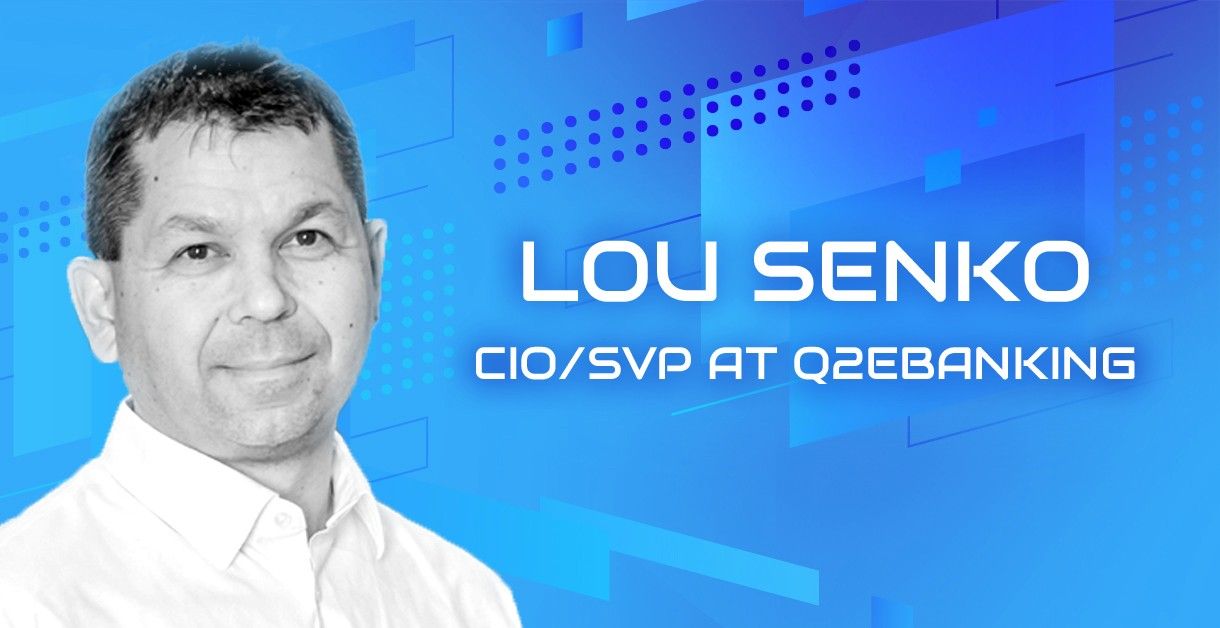How do you balance the demands of scaling technology startups? Resources are scarce in the beginning, the founder is likely wildly talented, but does not have all the expertise needed to guide the company, and missteps can be extraordinarily costly. Lou Senko, CIO/SVP at Q2ebanking, has some excellent insights on this topic, and I talked with him to learn more about his thoughts and experiences.
How can a technology start-up best balance the need to flash with the future need to scale the organization?
LOU: In the early days, most inventors of a technology worry about how they are going to scale. They spend their limited resources on infrastructure—office space—rather than focusing on the fundamentals. Critical fundamentals are more about organizational development and figuring out how you are going to develop the organization for growth just before you need to grow. Things like office space, computers, and more software licenses can be procured quickly, but you can’t recruit and develop people and the organization at large as quickly as you might think.
In the beginning, entrepreneurs’ seed capital is most often “the bank of family and friends.” Then, typically, an angel investor becomes involved; this investor is making a bet that the technology innovation will take off. When entrepreneurs get to the venture capital stage, they have enough resources to truly scale.
It is important to go through these stages because each stage will teach you something. In the early stages, inventors never know as much as they think they do.
Do you find that technology start-ups often ignore the fundamentals required to build a strong and viable company?
LOU: From my experience, often there’s a personality of one who is truly vested. They have done 90 percent of the early stage development work. They’re passionate, they understand how the technology works, and they’re super excited by the possibilities.
But the visionary inventor rarely understands what a scaled-up organization should look like, the needed product support structure, how to finance a company, and how the back office should function. Inventors do not need to understand these things—it is not their area of expertise. So they must surround themselves with people who can help to grow the organization at the right velocity, ultimately allowing the company to grow into a more mature and sustainable business.
The downfall of too many great ideas is that the founder/lead developer has a hard time letting go. They have a hard time handing their baby over to others who can use their areas of expertise to grow the business. There is a healthy friction that comes into play. Everyone around the founder sees all the problems, where the founder only sees opportunity. Ultimately, to be successful, the founder needs to have a trusted inner circle that is addressing the problems and working to grow the company.
How can start-ups find the right company leadership to help them grow?
LOU: The angel investor typically becomes the CEO. They’ve done this before and, typically, have scaled several companies. They have connections who they can call in to help and can bounce ideas off other people in the space because they have an extensive network. The angel investor has a pattern of success and trusts that they are making an excellent investment because they have a seat at the table and will play a key role in navigating the company.
How can start-ups compete within this tight technology labor market?
LOU: It’s the pitch, the vision, and the business case. No one is going to join your team unless you have an interesting vision for success. The founder has put a great deal of hard work into developing the thing—now they have to put in just as much work to show the world the value of their development.
The founder also has to prove to himself that there is value. Many times, the development is super cool, and the founder gets a lot of positive initial feedback. But when they get out there, there isn’t a need for the product and people will not write a check. Inventors have to face the reality of what that market tells them, while still having almost blind faith in what they’ve created. It’s a tricky balance.
How can more established organizations maintain innovation velocity?
LOU: It’s tough, and that’s exactly where I am at Q2ebanking. When I joined the company, it was pre-IPO, and I was employee number 286. Today we have 1,500 employees, and our stock has gone from $13 to $90. We had a million users then, and now we have 15 million. We had 240 servers, now we have 10,000. We’ve been on a huge growth curve, but we’ve been able to stay innovative because we have our original CTO. He doesn’t like constraints like budgets and planned work impede innovation. He reads an article about something that another innovative company is doing and he immediately finds a place where it solves a problem for us and wants to incorporate it now. The challenge is how to keep up and finish the last thing while now start this new thing.
It’s that creative energy that is still alive and well within our organization, that experiment-in-the-kitchen kind of behavior. The challenge is that we are now big and we can’t just shift gears and drop everything. We can’t go from experiment to customer anymore. The expectations of our organization and our solutions are now much too high for that. Plus, we are in the financial services space and we have to be careful because we deal with a lot of secure data and compliance demands.
So we’ve created an organization that can ingest these dreams that come from the R&D team led by our founding CTO, and then run them through production so we can quickly get a high-quality product out to customers.
Strong DevOps is one way we have been able to support rapid innovation while maintaining product quality and top levels of security. I have people who sit in the development teams. This allows us to fix performance, reliability, or quality issues upfront, and it’s so much less expensive and faster than waiting until we pass the new development off to the production department.
We’ve accelerated cycles of delivering innovations to customers by getting more programmatic with our nonfunctional requirements, like testing and security. We can fix problems quickly and cheaply, and allow highly quality innovations to speed through our system.
How has cloud computing helped innovation speed?
LOU: We have a big AWS and a big Azure footprint, but we also have two big data centers that have about $200 million dollars’ worth of technology in them. But we deploy “cloud-like” computing even when we are using our data centers.
So to us, it’s no different whether we’re hosting in our own data center or in the public cloud. However, I have a lot of hard infrastructure footprint within our own data centers, and that’s a disadvantage. But I can’t always achieve ROI because it’s actually not cheaper for me to go to the cloud, but the cloud helps to improve innovation speed. When we deploy in the public cloud, I don’t have to buy physical infrastructure and wait for installation: I can push a button, and the cloud is ready to go inside of fifteen minutes.
Why do you maintain your own data centers besides utilizing the public cloud?
LOU: The uptime in our data centers is actually better than in the public cloud, and we still get a lot of the benefits of the public cloud, like microservices computing, containers, resiliency, and all that. Since we are in a highly demanding regulatory environment, I have more control and our customers are more confident. Financial services customers have a lot of concerns about putting their customers’ data in a public cloud.
My data centers are less expensive than paying for monthly public cloud space. However, if I had elastic workloads, then I might use that elasticity to save costs, provided that the application would let me do it. It would be beneficial if I only had to pay for exactly what I need in a month; however, not all of our applications are like this.
Our company, Sphere Software (https://sphereinc.com), is the sponsor and organizer of Techdebates.org and also finds great value in these follow-up discussions with industry experts. The sphere is a technology consulting and solutions company. Everything we do is designed to accelerate your business, remove technical constraints, and eliminate staffing bottlenecks.






